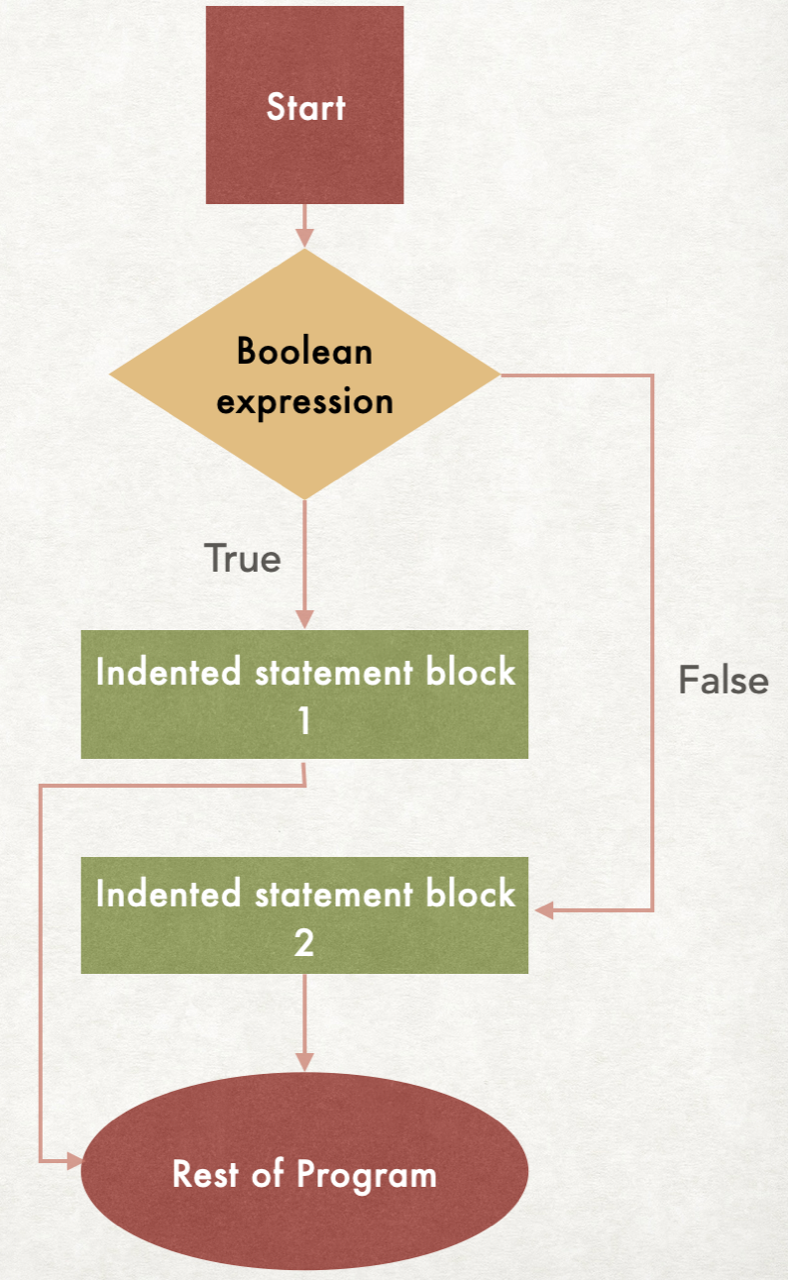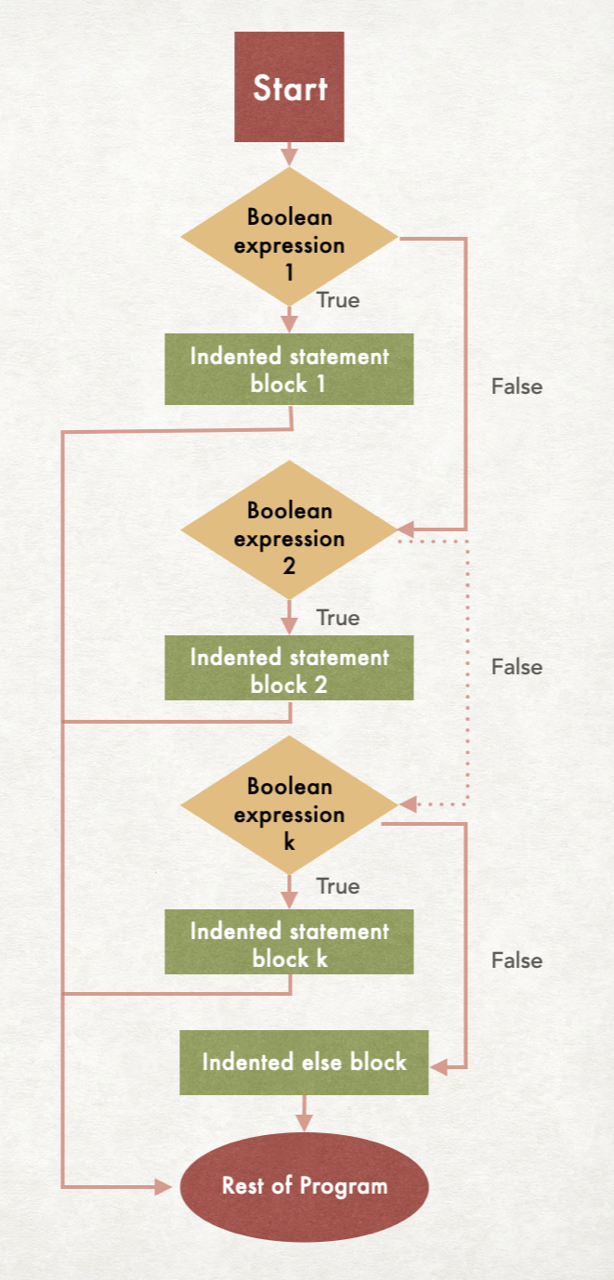Conditional statements (also called branch statements)
In python, conditional statements include if statements, if-else statements, and if-else ladders.
If statements
The syntax of an if statement is:
if <condition>:
# Indented statement block
# Rest of program
The condition is a boolean expression (in other words, it is True or False). The indented code block is executed if the condition evaluates to True, otherwise it is skipped. So the if statement controls whether or not that block of code runs. The indentation is extremely important - the indentation tells python which lines to skip if the condition is False.
This flowchart shows visually that the indented block of code is executed if the boolean expression is True, and is skipped if the boolean expression is False.

Examples of if-statements:
Trace the following code blocks and confirm the outputs.
| Code | Output | Notes |
|
|
|
|
|
|
|
|
|
If-else statements
An if-else statement gives the program an alternative block of code to execute if the condition in the if statement is False. The if-else statement will execute one (and only one) of the two code blocks
The syntax of an if-else statement is:
if <condition>:
# Indented statement block 1
else:
# Indented statement block 2
# Rest of program
The condition is a boolean expression (in other words, it is True or False). The indented code block 1 is executed if the condition evaluates to True, otherwise the indented code block 2 is executed. Thus we control which block of code to execute based on the True/False value of the condition.
This flowchart shows visually the path through an if-else statement:

Trace through the following examples of if-else-statements, and confirm the outputs.
| Code | Output | Notes |
|
|
Since |
|
|
This time |
Notice that in the above code, only one of "A" and "B" can be output, since one lies in the if block and the other lies in the else block. It is not possible for both to be output.
If-else ladder statements
We use an if-else ladder if there are more than two options - it allows for multiple branches. It will execute one block for each of many possible outcomes.
Here is the syntax for an if-else ladder:
if <condition_1>:
# Indented statement block 1
elif <condition_2>:
# Indented statement block 2
elif <condition_3>:
# Indented statement block 3
...
elif <condition_k>:
# Indented statement block k
else:
# Indented statement block
# Rest of program
Each of the conditions is a boolean expression (True or False). If the outcome of one of the conditions is True, then the associated indented statement block will get executed. Once that block is executed, the rest of the if-else ladder is skipped, so no further conditions are checked. This means that no more than one of the blocks will be executed.
Note that the last else block is optional. If the else block is omitted, and if none of the previous blocks gets executed, then no code at all in the if-else ladder will run.
Here is a flowchart for the if-else ladder:

Trace through the following examples of an if-else ladder and confirm the output:
| Code | Output | Notes |
|
|
The first condition The second condition No further conditions are checked - the rest of the code is skipped. |
|
|
The first condition The second condition The third and final condition Nothing is output! Notice that the same issue occurs if This code could benefit from a final |
|
|
The first condition This drops us into the |
Putting it all together
Here's a complete sample program demonstrating if-else ladders:
"""
A simple program to demonstrate an if-else ladder
Author: COMP 1351 Instructor
File Name: conditional_demo.py
Course: Comp 1351
Assignment: Preview of conditional statements
Collaborators: 1351 Instructors
Internet Sources: None
"""
"""
What to wear in Colorado based on temperature (integer degrees)
Winter jacket if it is less than 25 degrees
Light to medium coat if it is 25 to 44 degrees
Fleece if it is 45 and above, and less than 65 degrees
No jacket needed above 65 degrees
"""
def main():
# Find out the temperature:
temperature = int(input("What is the temperature today? "))
# Give user clothing recommendation based on temperature:
if temperature < 25:
print("You should wear a winter jacket.")
elif temperature >= 25 and temperature < 45:
print("You should wear a medium or light coat.")
elif temperature >= 45 and temperature < 65:
print("You should wear a fleece.")
else:
print("You do not need to wear a jacket.")
# Run the program:
if __name__ == '__main__':
main()
Key points:
-
The
elseblock guarantees that the program will give output no matter what the user enters. -
The program only accepts integer input. Entering a decimal value will result in a
ValueError. We will learn later how to respond to errors on user input. -
It's a common student error to create a boolean expression like this:
temperature >= 25 and <= 45. Both sides of theandoperator must be fully-formed boolean expressions. So it must saytemperature >= 25 and temperature <= 45. -
By the time we reach the line
elif temperature >=25 and temperature < 45we can already be sure that the temperature is greater than or equal to 25. For it if were not, then we would have executed the first indented block in theif, and skipped the rest of theif-elseladder. Thus, a simpler and still correct version of this ladder is:if temperature < 25: print("You should wear a winter jacket.") elif temperature < 45: print("You should wear a medium or light coat.") elif temperature < 65: print("You should wear a fleece.") else: print("You do not need to wear a jacket.")